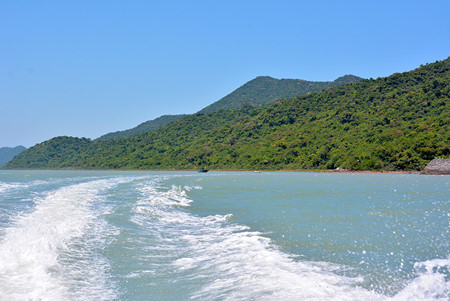This year the Viet Nam National Administration of Tourism has launched a program promoting Viet Nam as a paradise of sea and island for tourists. Besides traditional tourist destinations, travel agents have taken visitors to primitive places.

Bai Tu Long Bay, located next to Ha Long Bay, is a huge sea biosphere reserve accounting hundreds of islands and islets. One of them is the Ba Mùn island, the biggest wild life conservation site in Viet Nam’s northeastern region.
From Cai Rong Port in Van Don District, Quang Ninh Province, a high-speed boat will take you to Ba Mun Island of the Bai Tu Long Bay in about 45 minutes.
The island is called a wildlife animal paradise. It is covered by primeval forests which, together with high, sheer, dangerous rocks are the natural habitat of various kinds of animals.
The Ba Mun Island is located in the core of Bai Tu Long Bay and is the only schist island having primeval forests. Ba Mun covers an area of about 1,800 ha.
On the east side of the island, which is known locally as the “exterior”, strong waves continuously hit the cliffs to create bubbles and foam up to tens of meters high.

The western side, or the “interior”, on the other hand features tranquil scenery and calm water that ripples around the boat.
Ba Mun Island has no indigenous residents, only rangers and wildlife rescuers of Bai Tu Long National Park.
They told us that the Park shelters about 2,000 species of fauna and flora, including 72 animals and 32 plants listed in Viet Nam’s Red Book of endangered species. Many of them are living on Ba Mun Island.
The most prominent plants are teakwood, sindora, and ironwood species. The Lan hai orchid (Cypripedioideae), which was mistakenly thought to be extinct a few years ago, still exists here.
At the present, this orchid species is found only in Lao Cai Province and Ba Mun Island.
Ba Mun is home to several rare species of animals, including golden deers, antelopes, monkeys, langurs, as well as sea and migratory birds. The rangers can still see many wild boars, deers, and muntjacs in search of food.
Since the Bai Tu Long National Park was established in 2001, wildlife preservation on the Ba Mun Island has been tightened. A rescue center opened there in 2010 to take care of its wildlife as well as those rescued from illegal trafficking cases.
Pham Ngoc Bien, a wildlife rescuer, has been working on the island for 5 years. Confiscated animals from illegal trafficking cases are weak, exhausted, and panic because they were caged and transported from places to places for a long time. Bien says they have to treat the animals carefully.
“We feed the monkeys with potatoes, gourds, pumpkins, and sweet potatoes. The tortoises eat meat or vegetable. Pythons eat chicken but don’t eat dead animals. Sometimes we have to spoon-feed the very weak or small ones. We have to slide in the meat for the hawks. Wild animals are dangerous: sometimes the monkeys bite us,” he said.
Besides feeding the animals, the rescuers also treat their mental and physical illnesses. When they are healthy and have got back their instinct, they will be released to the wild.
Every year the team saves hundreds of turtles, tortoises, snakes, copperheads, Tibetan bears, weasels, foxes, civets, and wildcats.
Bien said some monkeys, which were freed into the forests, have regularly returned to the rescue center to meet people here. "Our work is hard to some extents, because isn’t like in the mainland. The rescuers and rangers work together to patrol the forests and trace animal footprints and marks. We take care of the animals and document the fauna and flora species on the island.”
About 80% of the rescued animals have survived and have been released into the forests, which increases the animal population on Ba Mun Island.
Vu Ngoc Than, Deputy Director of Bai Tu Long National Park, said, “Managing and protecting Bai Tu Long National Park is the key task in preserving and promoting biodiversity. We have strengthened security to prevent intruders from exploiting the park’s natural resources.”
In recent years, the Ba Mun Island and the Bai Tu Long National Park have been open to not only scientists and researchers, but also to tourists.
They can explore the island on their own, following natural trails in the forest or ranger patrol routes. It takes at least 3 days to complete a full tour of the Ba Mun Island.